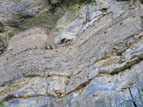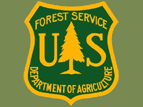The Sierra Ancha Wilderness is located about 100 miles east of Phoenix, between Globe and Young. Though fairly small at 32 square miles, it contains some of the most rugged and inaccessible terrain in Arizona.
Most of the Sierra Ancha Wilderness lies at an elevation of about 7000 feet. But along the eastern border, Cherry Creek has cut a substantial valley down to an elevation of 3000 to 3500 feet. The four thousand foot elevation change from the mesa top to the river results in a series of vertical-walled canyons cutting back into the mesa towards the west. Within these canyons, virtually any south-facing location with a protective overhang and sufficient building space contains a structure of some kind. Two of the most widely publicized sites—Devil's Canyon ruin and the Pueblo Canyon group—are documented on the following pages.

1. Pueblo Canyon Group
Three independent multi-room ruins, and some spectacular scenery. Click on the thumbnail to go to the page.

2. Devil's Chasm Ruin
Perhaps the single most impressive ruin in the Sierra Anchas, and one of the least accessible. Click on the thumbnail to go to the page.
The ruins of the Sierra Anchas present somewhat of a mystery to archeologists. From 500 to 950 AD the region stood at the boundary between three distinct traditions: the Mogollon to the east, the Hohokam to the west, and the Sinagua to the north. Then about 950 AD a new culture—the Salado—appeared, occupying a region almost 100 miles across with the Sierra Anchas near its center. Tree ring dating of timbers used in construction indicates that the Anchan ruins were built and occupied over a relatively short seventy year period, from 1280 to 1350, which would make them Salado in origin. However, certain elements of the architecture, tools and pottery show a strong Mogollon influence as well. Adding to the mystery is the fact that the ruins are constructed in extremely inaccessible locations, raising the possibility that defense against invasion was a strong motivation. It has been suggested that this may have been the remnants of an older or hybrid community that managed to cling to its traditions for some time after the surrounding area was occupied by the Salado. At the present time, archeologists simply refer to the inhabitants as the "Anchan Tradition."

Link to U.S. Forest Service's Sierra Ancha Web Site
The Siera Ancha Wilderness is administered by the Tonto National Forest Pleasant Valley Ranger District of the U.S. Forest Service. Click the thumbnail for the Forest Service's Sierra Ancha web page.
Cherry Creek Road (FR 203) branches off from State Route 288 just south of the Sierra Ancha Wilderness, follows along the east side of the Wilderness boundary along Cherry Creek for about forty miles, and rejoins 288 to the north, fifteen miles south of Young. In years past it was possible to drive the entire route in a suitable high-clearance vehicle. Today (March of 2008), the road is all but impassable. Coming from the south, the second ford of Cherry Creek is rutted and deep, and should not be attempted unless the water is very low. A few miles farther north at Devil's Chasm, the road is washed out so completely that even quads and dirt bikes are unable to pass. Coming in from the north, the road is passable to quads and bikes (barely) as far as Devil's Chasm, but normal 4WD vehicles are too wide to make it past the many washouts.
Update - April 2009: The washout of Cherry Creek Road at Devil's Chasm has been partially repaired, and is now passable to short-wheelbase 4WD vehicles. Suburbans and the like will still have trouble.